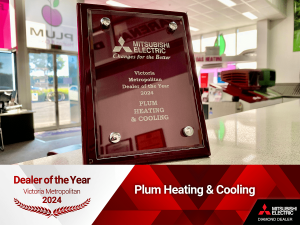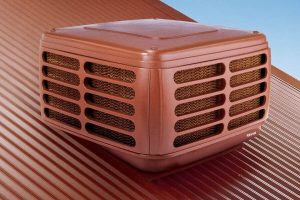Discover the Future of Heating
Geothermal heating is a revolutionary heating system that utilises the natural heat from the Earth to provide warmth and comfort to homes and buildings. Unlike traditional heating methods that rely on burning fossil fuels, geothermal heating harnesses the renewable energy stored in the ground, making it an environmentally friendly and sustainable option.
The concept behind geothermal heating is simple yet ingenious. The Earth’s crust maintains a relatively constant temperature throughout the year. Geothermal heating systems take advantage of this stable temperature by using a series of pipes, known as a ground loop, buried underground. These pipes are filled with a water-based solution that absorbs the heat from the ground.
The heat absorbed by the solution is then transferred to a heat pump located inside the building. The heat pump amplifies the temperature of the absorbed heat and distributes it throughout the building via a network of ducts using a ducted refrigerated heating system. In the summer, the process can be reversed, with the heat pump extracting heat from the building and transferring it back into the ground, providing efficient cooling.
One of the key benefits of geothermal heating is its high energy efficiency. By utilising the Earth’s natural heat, geothermal systems can achieve heating efficiencies of up to 400%, meaning that for every unit of electricity used to power the system, it can produce up to four units of heat. This high efficiency translates into significant energy savings and lower utility bills for homeowners and businesses.
Furthermore, geothermal heating systems are known for their longevity and low maintenance requirements. The underground components of the system can last for decades, and the heat pump typically has a lifespan of 20 to 25 years. With proper maintenance, geothermal heating systems can provide reliable and consistent heating and cooling for many years.
Watch Rinnai’s unbeatable Geothermal Heating Products, known as Geoflo.
In conclusion, geothermal heating is a sustainable and efficient heating solution that taps into the Earth’s natural heat to provide warmth and comfort. With its numerous benefits, including energy savings, environmental friendliness, and long-term reliability, geothermal heating is undoubtedly the future of heating systems.
Benefits of Geothermal Heating Systems
Geothermal heating systems offer numerous benefits that make them an attractive option for homeowners and businesses alike. This section will explore some of the key advantages of geothermal heating systems.
- Energy Efficiency: Geothermal heating systems are highly energy-efficient compared to traditional heating methods. They utilise the constant temperature of the earth to provide heating, which requires less energy than other systems. This can result in significant energy savings and lower utility bills.
- Environmental Friendliness: Geothermal heating systems are considered environmentally friendly because they produce fewer greenhouse gas emissions compared to fossil fuel-based heating systems. They do not burn any fuel, reducing the carbon footprint and helping to combat climate change.
- Cost Savings: While the initial installation cost of a geothermal heating system may be higher than traditional systems, the long-term cost savings can be substantial. The energy efficiency of geothermal systems can lead to lower monthly heating bills, resulting in significant savings over time.
- Durability and Longevity: Geothermal heating systems are known for their durability and longevity. The underground components of the system can last for decades, and the heat pump typically has a lifespan of 20 to 25 years. This means that once installed, geothermal systems require minimal maintenance and can provide reliable heating for many years.
- Versatility: Geothermal heating systems can be used for both heating and cooling purposes. They can provide efficient heating during the winter months and can also be used for cooling during the summer by reversing the heat exchange process. This versatility makes geothermal systems a comprehensive solution for year-round comfort.
- Quiet Operation: Geothermal heating systems operate quietly compared to traditional heating systems. The absence of noisy outdoor units or compressors makes them ideal for residential areas where noise pollution is a concern.
In conclusion, geothermal heating systems offer a range of benefits that make them an attractive option for those seeking efficient, environmentally friendly, and cost-effective heating solutions. From energy savings to durability and versatility, geothermal systems provide a long-term heating solution that can contribute to a greener future.
Installation Process of Geothermal Heating Systems
The installation process of geothermal heating systems is a crucial step in harnessing the benefits of this innovative heating method. This section will provide a detailed overview of the installation process, including the necessary steps and considerations.

- Site Assessment: Before installing a geothermal heating system, a thorough site assessment is conducted to determine the feasibility and suitability of the location. Factors such as soil conditions, available land area, and access to groundwater or wells are evaluated to ensure optimal system performance.
- Design and Sizing: Once the site assessment is complete, the next step is to design and size the geothermal heating system. This involves calculating the heating and cooling loads of the building, determining the appropriate size and number of geothermal heat pumps, and designing the loop system.
- Loop System Installation: The loop system is a crucial component of geothermal heating systems. There are two main types of loop systems: closed-loop and open-loop. Closed-loop systems circulate a mixture of water and antifreeze through a series of underground pipes, while open-loop systems utilise groundwater from a well. The installation of the loop system involves excavating trenches or drilling boreholes, laying the pipes, and connecting them to the heat pump.
- System Installation: The condenser and indoor refrigerated unit is the heart of the geothermal heating system. It extracts heat from the ground or water source and transfers it to the building for heating. The indoor unit is typically installed in the ceiling or under the floor. The installation process includes connecting the condenser to the loop system, electrical wiring, and ductwork.
- Testing and Commissioning: After the installation is complete, the geothermal heating system undergoes thorough testing and commissioning to ensure proper functioning. This includes checking for leaks, verifying system performance, and adjusting settings as needed.
By following these installation steps and considering the specific requirements of the site, geothermal heating systems can be successfully implemented, providing efficient and sustainable heating solutions for residential and commercial buildings.
Cost Analysis of Geothermal Heating Systems
Geothermal heating systems are known for their energy efficiency and long-term cost savings. In this section, we will delve into the cost analysis of geothermal heating systems to help you understand the financial aspects of this heating method.
When considering the cost of geothermal heating systems, it is important to look at both the upfront installation costs and the long-term savings. The initial installation cost of a geothermal heating system can be higher compared to traditional heating systems. This is because geothermal systems require specialised equipment and drilling or excavation for the installation of ground loops or wells. However, it is important to note that the installation cost can vary depending on factors such as the size of the property, the type of system chosen, and the local geology.
Despite the higher upfront cost, geothermal heating systems offer significant long-term savings. This is primarily due to their high energy efficiency. Geothermal systems utilise the constant temperature of the earth to heat and cool your home, which requires less energy compared to traditional heating methods. As a result, homeowners can expect to see a reduction in their energy bills over time.
In addition to energy savings, geothermal heating systems also have a longer lifespan compared to traditional heating systems. While traditional systems may need to be replaced every 10-15 years, geothermal systems can last for 20-25 years or more with proper maintenance. This means that homeowners can save on replacement and maintenance costs in the long run.
In conclusion, the cost analysis of geothermal heating systems reveals that while the upfront installation cost may be higher, the long-term savings in energy bills and maintenance costs make it a cost-effective heating option. By embracing geothermal heating, homeowners can not only enjoy a comfortable and efficient heating system but also save money in the long run.
Efficiency of Geothermal Heating Systems

Geothermal heating systems are known for their high efficiency and energy-saving capabilities. In this section, we will explore the efficiency of geothermal heating systems and how they compare to other heating methods.
One of the key factors that contribute to the efficiency of geothermal heating systems is their use of renewable energy from the earth’s heat. Unlike traditional heating systems that rely on burning fossil fuels, geothermal systems harness the natural heat stored in the ground. This renewable energy source allows geothermal systems to operate with significantly higher efficiency, resulting in lower energy consumption and reduced carbon emissions.
The efficiency of a geothermal heating system is typically measured by its coefficient of performance (COP). The COP represents the ratio of heat output to the amount of electricity input. Geothermal systems have COP values ranging from 3 to 5, meaning that for every unit of electricity consumed, they produce three to five units of heat. This high COP makes geothermal heating systems up to 50% more efficient than traditional heating methods.
Furthermore, geothermal systems can also be equipped with advanced technologies, such as variable-speed compressors and smart thermostats, which further enhance their efficiency. Variable-speed compressors allow the system to adjust its output based on the heating demand, ensuring optimal performance and energy savings. Smart thermostats enable homeowners to program and control their geothermal systems remotely, allowing for better temperature management and energy efficiency.
Compared to other heating methods, geothermal systems offer superior efficiency and cost savings. While the upfront installation costs of geothermal systems may be higher than traditional heating systems, the long-term energy savings can offset these initial expenses. Additionally, geothermal systems have a longer lifespan and require less maintenance, further contributing to their overall efficiency and cost-effectiveness.
In conclusion, geothermal heating systems are highly efficient due to their use of renewable energy and advanced technologies. With their high COP values and energy-saving features, geothermal systems offer significant cost savings and environmental benefits. By embracing geothermal heating, homeowners can not only enjoy a comfortable indoor environment but also contribute to a sustainable future.
Comparisons between Geothermal Heating and Other Heating Methods
In this section, we will explore the comparisons between geothermal heating and other heating methods commonly used in residential and commercial settings. By understanding the differences and similarities, readers can make informed decisions about which heating system is best suited for their needs.
One of the primary comparisons to be made is between geothermal heating and traditional heating methods. While other units rely on natural gas or oil to generate heat, geothermal heating systems utilise the constant temperature of the earth to provide warmth. This key difference makes geothermal heating systems more environmentally friendly and sustainable, as they do not produce greenhouse gas emissions during operation.
Another important comparison is the efficiency of geothermal heating systems compared to other methods. Geothermal heating systems are known for their high efficiency, as they can provide up to four units of heat for every unit of electricity used. In contrast, traditional heating methods may have lower efficiency ratings, resulting in higher energy consumption and costs.
Cost is also a significant factor when comparing heating methods. While geothermal heating systems may have higher upfront installation costs, they can provide long-term savings through reduced energy bills. Additionally, geothermal systems have a longer lifespan compared to traditional heating methods, which may require more frequent repairs and replacements.
Maintenance requirements and troubleshooting are also worth considering. Geothermal heating systems generally have lower maintenance needs compared to traditional heating methods. Troubleshooting common issues with geothermal heating systems may involve checking the circulation pump, and thermostat settings, or inspecting the ground loop for any leaks or damage.
By providing these comparisons, readers can gain a comprehensive understanding of the advantages and disadvantages of geothermal heating systems compared to other heating methods. This information can help them make informed decisions when it comes to selecting the most suitable heating system for their homes or businesses.
Tips for Maintenance of Geothermal Heating Systems
Proper maintenance is essential for ensuring the longevity and efficiency of geothermal heating systems. Here are some tips to help you maintain your system:
- Regular Inspections: Schedule regular inspections with a professional geothermal heating contractor to ensure that your system is functioning optimally. They can check for any leaks, blockages, or other issues that may affect its performance.
- Clean the Air Filters: Geothermal heating systems have air filters that need to be cleaned or replaced regularly. Clogged filters can restrict airflow and reduce the system’s efficiency. Check the manufacturer’s guidelines for the recommended frequency of filter cleaning or replacement.
- Check the Refrigerant Levels: The refrigerant in a geothermal heating system plays a crucial role in heat transfer. Low refrigerant levels can lead to reduced heating capacity. Have a professional check the refrigerant levels and top them up if necessary.
- Inspect the Heat Exchanger: The heat exchanger is responsible for transferring heat between the geothermal system and your home. Regularly inspect it for any signs of damage or corrosion. If you notice any issues, contact a professional for repairs or replacement.
- Clean the Coils: The coils in a geothermal heating system can accumulate dirt and debris over time, affecting their efficiency. Clean the coils periodically to remove any buildup. Be sure to follow the manufacturer’s instructions or consult a professional for guidance.
- Monitor the Thermostat: Keep an eye on your thermostat to ensure that it is functioning correctly. If you notice any irregularities in temperature control or system operation, it may indicate a problem that requires attention.
- Protect the Ground Loop: The ground loop is a vital component of geothermal heating systems. Take measures to protect it from damage, such as avoiding construction or heavy machinery near the loop area.
By following these maintenance tips, you can keep your geothermal heating system in optimal condition, ensuring efficient and reliable heating for your home. Remember to consult with a professional for any major repairs or maintenance tasks to ensure the safety and effectiveness of your system.
Troubleshooting Common Issues with Geothermal Heating Systems
Geothermal heating systems are known for their efficiency and reliability. However, like any other heating system, they may encounter issues from time to time. In this section, we will discuss some common problems that can occur with geothermal heating systems and provide troubleshooting tips to help you resolve them.
One common issue with geothermal heating systems is a loss of heat or insufficient heating. This can be caused by a variety of factors, such as a malfunctioning thermostat, a clogged air filter, or a refrigerant leak. To troubleshoot this problem, you can start by checking the thermostat settings and ensuring that it is set to the desired temperature. If the thermostat seems to be functioning properly, you can then check the air filter and clean or replace it if necessary. If these steps do not resolve the issue, it may be best to contact a professional geothermal heating contractor for further assistance.
Another issue that can occur with geothermal heating systems is a lack of hot water. This can be caused by a faulty heat pump or a problem with the water heater. To troubleshoot this problem, you can start by checking the heat pump and ensuring that it is running properly. If the heat pump seems to be functioning correctly, you can then check the water heater and make sure it is set to the appropriate temperature. If these steps do not resolve the issue, it is recommended to contact a professional for further diagnosis and repair.
Additionally, geothermal heating systems may experience issues with noise or vibration. This can be caused by loose components, such as fan blades or motor mounts. To troubleshoot this problem, you can start by inspecting the system for any loose or damaged parts. If you find any, you can tighten or replace them as needed. If the noise or vibration persists, it is best to consult a professional for further assistance.
In conclusion, while geothermal heating systems are generally reliable, they can encounter issues from time to time. By understanding common problems and following troubleshooting tips, you can effectively resolve these issues and ensure the continued efficiency and performance of your geothermal heating system.
Finding Geothermal Heating Contractors in Your Area
When it comes to installing a geothermal heating system, it is important to find a reliable and experienced contractor who specialises in this type of technology. Finding the right geothermal heating contractor in your area can ensure that the installation process goes smoothly and that you get the most out of your system.
One of the best ways to find geothermal heating contractors is by asking for recommendations from friends, family, or neighbors who have already installed geothermal heating systems. They can provide valuable insights into their experience with different contractors and help you make an informed decision.
Another option is to search online directories or websites that specialise in connecting homeowners with local contractors. These platforms often provide reviews and ratings from previous customers, giving you a better idea of the contractor’s reputation and quality of work.
It is also a good idea to contact multiple contractors and request quotes for the installation of a geothermal heating system. This will allow you to compare prices, services offered, and warranties provided by different contractors. Keep in mind that the lowest price may not always be the best option, as quality and experience should also be taken into consideration.
When it comes to Geothermal Heating, Plum Heating and Cooling are experts who are able to advise the best way to tackle your Geothermal Heating project.
Additionally, consider scheduling consultations with the contractors you are considering. This will give you an opportunity to ask questions, discuss your specific needs and requirements, and gauge their level of professionalism and expertise.
In conclusion, finding a reputable geothermal heating contractor in your area is crucial for a successful installation of a geothermal heating system. By asking for recommendations, utilising online directories, and comparing quotes, you can find a contractor who is experienced, qualified, and trustworthy. Taking the time to find the right contractor will ensure that your geothermal heating system operates efficiently and effectively, providing you with long-term energy savings and comfort in your home.
Embracing the Future of Heating with Geothermal Heating Systems
In conclusion, geothermal heating systems offer a promising future for heating homes and buildings. With their numerous benefits, efficient operation, and cost-effectiveness, they are becoming an increasingly popular choice among homeowners and businesses.
Geothermal heating systems provide a sustainable and environmentally friendly heating solution. By utilising the natural heat stored in the earth, they reduce reliance on fossil fuels and minimise greenhouse gas emissions. This not only helps combat climate change but also contributes to a cleaner and healthier environment.
The installation process of geothermal heating systems may require some upfront investment, but the long-term cost savings make it a worthwhile investment. These systems have lower operating costs compared to traditional heating methods, as they require less energy to operate. Additionally, geothermal heating systems have a longer lifespan, reducing the need for frequent replacements and repairs.
When compared to other heating methods, geothermal heating systems come out on top in terms of efficiency. They can provide consistent and comfortable heating throughout the year, regardless of the outside temperature. This eliminates the need for separate heating and cooling systems, resulting in further energy savings.
Maintenance of geothermal heating systems is relatively simple, with routine check-ups and filter replacements being the main tasks. However, in the event of any issues, troubleshooting can be done with the help of professionals or through online resources.
To embrace the future of heating with geothermal systems, it is essential to find reliable and experienced geothermal heating contractors in your area. These professionals can guide you through the installation process, provide maintenance services, and ensure the optimal performance of your system.
In conclusion, geothermal heating systems offer a sustainable, cost-effective, and efficient solution for heating homes and buildings. By harnessing the power of the earth’s natural heat, we can reduce our carbon footprint and create a more sustainable future. So, if you are considering a new heating system or looking to upgrade your existing one, geothermal heating is definitely worth exploring. Embrace the future of heating with geothermal heating systems and enjoy the benefits they bring.
What is geothermal heating?
Geothermal heating is a renewable energy system that uses the heat stored beneath the Earth’s surface to provide heating and hot water for buildings.
How does geothermal heating work?
Geothermal heating systems utilise a heat pump to extract heat from the ground and transfer it to a building. This process is highly efficient and eco-friendly.
What are the main components of a geothermal heating system?
A geothermal heating system consists of a heat pump, ground loop (either closed or open), and a distribution system (ducts or radiant floor heating)
Is geothermal heating cost-effective?
Geothermal heating can be cost-effective in the long run, as it can significantly reduce energy bills and offers a reliable, low-maintenance heating solution.
Are there different types of geothermal heat pumps?
Yes, there are two main types: ground source heat pumps (GSHPs) and water source heat pumps (WSHPs). GSHPs are more common and use the Earth’s ground as a heat source, while WSHPs extract heat from water bodies.
What is the lifespan of a geothermal heating system?
Geothermal heating systems are known for their durability and can last up to 25 years or more for the heat pump and up to 50 years for the ground loop.
What are the environmental benefits of geothermal heating?
Geothermal heating produces minimal greenhouse gas emissions, making it an eco-friendly option that reduces a building’s carbon footprint.
Can geothermal heating be used for cooling as well?
Yes, geothermal heat pumps can provide both heating and cooling by reversing the heat transfer process, making them versatile for year-round comfort.
Is geothermal heating suitable for all regions and climates?
Geothermal heating can be effective in various climates, but the feasibility and cost-effectiveness may vary depending on factors like soil type, geology, and local climate conditions.
What maintenance is required for a geothermal heating system?
Regular maintenance includes checking the heat pump, inspecting the ground loop for leaks, and ensuring proper fluid levels. Maintenance needs are generally lower compared to traditional HVAC systems.










